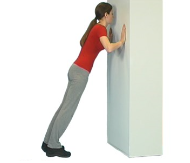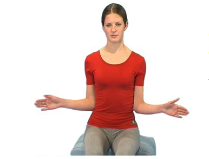Rotator Cuff Related Shoulder Pain
What you should know
Rotator Cuff Related Shoulder Pain is a term used to describe irritation of the rotator cuff tendons (tissue that attaches muscle to the bone) underneath the bony arch of the shoulder. It’s also described as subacromial pain syndrome, shoulder impingement, bursitits or tendinopathy.
The pain is generally felt in the outer aspect of the upper arm but can radiate further down the arm and up towards the neck and shoulder blade. It can feel worse when the arm is moved away from the body such as reaching up or when placing the hand behind the back.
Pain can come on slowly over time or quite quickly if the shoulder has been used for an activity that is much more demanding than it is used to doing each day. Other risk factors include postural problems, overuse, especially lifting above head or overhead decorating, or heavy gym work, especially chest focused.
The good news is that in most cases it isn’t a serious problem and will usually get better over time.
What to do
There are many ways in which you can help reduce the pain. Although they may not remove the pain completely they should reduce it.
Keep moving
Staying generally active is the most important way you can help yourself if you have rotator cuff related shoulder pain. It releases chemicals called endorphins, which are the body’s natural painkillers. These improve pain and make you feel happier.
General exercise might make your shoulder feel a bit sore at first but it doesn’t cause any harm – so don’t let it put you off. It’s important that you continue to exercise regularly and don’t stop when the pain is gone and you’re feeling better, for your long-term general health.
Research has demonstrated that if people suffering with this common problem do the right type of rehabilitation exercises then they can successfully treat themselves.
Pain medication
Keeping on top of the pain can help you to move the shoulder and can treat any inflammation.
It may surprise you, but simple over the counter painkillers such as paracetamol and ibuprofen are the most effective pain medication. If you feel you need them – use them. You should only take the recommended daily dose but do not wait until your pain is out of control to take them.
Consult with your GP/Pharmacist if you have any concerns and do not take ibuprofen or aspirin if you are pregnant or have asthma, an ulcer or indigestion.
Hot/cold
An ice/cold pack in the first 0-72 hours can be used to help reduce shoulder pain. Only use for 10-15 minutes on protected skin.
After this period heat; such as a hot water bottle, a bath or a shower can be an excellent effective way to reduce pain. Again use for 10-15 minutes.
For both hot and cold you should make sure there is something between your skin and the source of heat/cold such as a paper towel or tea towel.
Sleep
Sleep is really important when it comes to managing pain. Studies suggest that getting a good night’s sleep can reduce pain levels by as much as 25%.
Tips to improve your sleep include;
- Sleep in a dark, quiet and cool room
- Support your shoulder or arm with a pillow if needed
- Try taking your pain relief an hour before you go to bed
- Do not consume caffeine within 6 hours of sleeping
- Try to avoid eating within 2 hours of sleeping
- Try to not be in front of bright screens such as TVs, laptops and phones for 1 hour before bed
- Keep your bedroom as a place to sleep do not use it for work or as an office
- If you do wake in the night and cannot get back to sleep, get up, go to another room and do something until you are tired before going back to sleep
Diet and nutrition
There are no special diets that have been shown to either help or prevent shoulder pain.
What’s recommend for us all is a well-balanced and healthy diet, which is low in saturated fats, sugar and salt. It’s also a very good idea to eat plenty of fresh fruit and vegetables, and to drink plenty of water.
If you need to lose weight, the key is to regularly burn off more energy than you consume on a daily basis.
Exercise
If an exercise is painful to undertake/or causes a moderate to high level of pain during or afterwards, then reduce the difficulty level or stop that particular exercise.
As with rehabilitation for tendon problems anywhere in the body, it can take time to see the benefit from performing exercises.
You may only be able to move your arm a small amount at the start but this will improve over time. A small increase in pain while exercising is ok as long as it goes away within 30 minutes and is not worse the next day. If this happens, don’t worry, do fewer repetitions the next time and then gradually build up again.
- Wall slides - find a smooth wall or wall mirror and a cloth that will slide easily on the wall (or put clean socks on your hands). Stand facing the wall and place the edges of your hands against the wall with your thumbs facing you. Now step forward as you gently push into the wall and slide your hands up as far as you can. Relax and return to start position. Repeat 8 times; rest for a minute; repeat 8 times; rest for a minute; repeat 8 times; rest for a minute. When you can do this exercise easily you can progress by doing it without the support of the wall and adding a light weight.

.png)
- Push-ups against the wall - put your hands on the wall as if you are going to do a push-up. Make sure your hands are placed a little wider than the width of your shoulders, your hands are turned out slightly and your elbows are below your shoulders. Now lower your body towards the wall keeping your body nice and tall. Repeat 8 times; rest for a minute; repeat 8 times; rest for a minute; repeat 8 times; rest for a minute. When you can do this exercise easily you can progress and increase load by moving your feet further from the wall.

.png)
- Shoulder rotation - sit or stand with your elbow tucked in at your side and turn the forearm out the side. Return to the start position and relax. Make sure you sit up tall whilst you do this. When it is easy for you to do this you can add a light weight – start with half kilo or a small 500ml water bottle. As the exercise gets easier you can increase the weight: firstly to 1 kilo; then to 1 and half kilos; and finally to 2 kilos.

When to see your GP/Physiotherapist
- If you have had an accident or trauma to the shoulder
- If you are experiencing power loss after a trauma or fall onto an outstretched hand
- If you have any redness or swelling of the shoulder
- If you feel unwell or have a fever
- If you have developed a new cough or have breathlessness as well as shoulder pain
- If you have a history of cancer, osteoporosis, steroid use, or excessive drug or alcohol use
- If your symptoms have not improved with the exercises above after a month
Further resources
- NHS Conditions - Shoulder Impingement Syndrome
- Versus Arthritis Shoulder Pain Information Booklet
- Versus Arthritis Shoulder Pain Leaflet
- Versus Arthritis Exercises
- NHS - Sleep problems
- NHS - Lose weight (includes the NHS app for weight loss)
- NHS - Quit smoking (includes the NHS quit smoking app)
Authors: Catrin Maddocks, Jemima Cope, Jane Leah and Cianán O’Sullivan
Review Date: February 2026